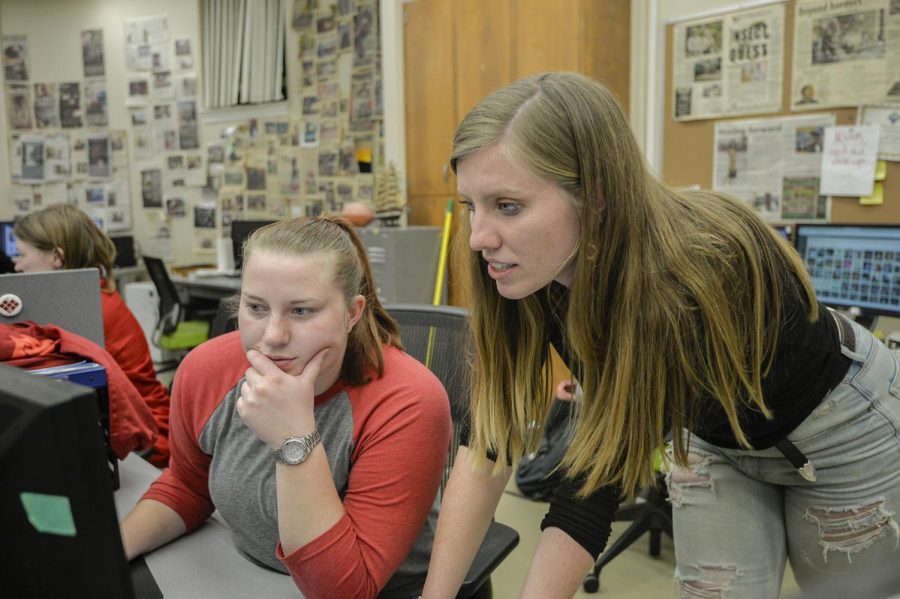Editorial Board: Sports need women writers
Female athletes, sports writers alike deserve to be taken seriously
JACQUI THOMASSON | THE DAILY EVERGREEN
Sports editors Katie Archer, left, and Grace Arnis work on laying out their section for the last paper of the fall semester in The Daily Evergreen newsroom on Thursday.
December 6, 2019
The second result that appears when you search for “women sports reporters” is a ranking of attractive female sports reporters. The third article is about harassment and sexism women still face in the workplace. Scroll down further, and there are three more listicles that also rank the “hottest” female sports reporters.
At the beginning of the semester, the Sports and Deputy Sports Editor decided they were determined to do everything they could to increase the coverage of women’s sports at WSU.
In the world of sports journalism, women’s coverage is underrepresented. Most newsrooms, and especially sports sections, have historically been dominated by men.
Nationally, only 14 percent of all sports reporters are women and women’s sports only account for about 4 percent of sports media. This can be strange to think about when one of the biggest stories in sports this year centered around the United States women’s national soccer team.
This semester we wanted to change that. We did this through the all-women’s sports weekend dedicated to female athletes at WSU. We also increased our focus on soccer and volleyball this semester and encouraged our reporters to build strong working relationships with the athletes and sports information directors.
Pullman is a small community. Sometimes, this means the only time a sport gets consistent coverage is when we report on it. This happened this semester with WSU women’s soccer.
Our soccer beat reporter was often the only person at a game to write a recap, her features the only time a player would be the focus of an article. She consistently pitched stories our editorial staff was not aware of because she spent so much time with the team.
So when we started working to send her and a photographer to the NCAA Women’s College Cup this Monday, one of our editors noted, happily, that both the photographer and reporter going would be women.
Immediately after the editor made this comment, an administrator in the room felt the need to tell her that the story wasn’t about gender.
Later, in a different conversation, he told a different editor that if we didn’t cover the match at all, no one would notice.
Respectfully, this mindset is exactly the problem.
The WSU women’s soccer team is the highest performing team at WSU this decade. They reached the College Cup after not being ranked in the NCAA tournament. Thursday, Morgan Weaver became the second player in team history to be named an All-American.
Objectively, their run in this postseason is newsworthy. Last year, we were never questioned for sending a reporter and a photographer to the Alamo Bowl. But, for a female reporter going to a women’s soccer game it was a question we had to fight over.
This reporter faced other unfair treatment this semester.
An article she wrote over Thanksgiving received 300 reactions and over 40 shares online. Someone then commented “Damn. This writer is smoking hot,” on our website. This is the only comment we received based on a reporter’s appearance this semester.
We didn’t approve the comment, however, it underscored an important point: female sports reporters today are facing the same issues they always have. It’s one of the reasons women in sports reporting have been few and far between for so long. It is, in our opinion, no small part of why media coverage of women’s sports has been lacking.
So when we celebrate having women covering sports events, it’s because it’s reflective of progress on an issue that is, in fact, about gender.
We cover women’s sports not only because we believe in fair coverage but also because our audience is interested. The article written about the Cougars winning in the Elite Eight to make the Final Four received more interactions on our Facebook page than any of the football articles we published this semester.
Inevitably, not everyone will agree the status quo needs to change. Some readers may see The Daily Evergreen’s efforts as unnecessary or even harmful.
Despite that, the reality is that men’s sports have been front and center in the media since newspapers started covering them — but just because something is traditional doesn’t make it right.
Increased inclusion of women’s sports coverage and women sports reporters are not an attack on the men in those professions. The Daily Evergreen will continue to work for more equitable coverage in sports and beyond.










Roger Crawford • Dec 7, 2019 at 8:02 pm
Good on you. I enjoyed all the stories and am impressed with your success. Fight on.
Ron Rhodes • Dec 7, 2019 at 2:03 pm
It’s ideas and missions like yours that make me proud to be a Coug.
Dean Hare • Dec 6, 2019 at 9:01 pm
Love this!
When I was a student photographer at The Daily Evergreen, I loved covering women’s sports. Because I was often the only Evergreen photographer they ever saw, I made enduring friendships with many of the student athletes.
I wish more Cougar students, staff, faculty and alumni would attend womens’ sports games — if for no other reason than they represent WSU just as much as the men do.
Go Cougs!
Dean Hare
2002-2006 Daily Evergreen Alumnus